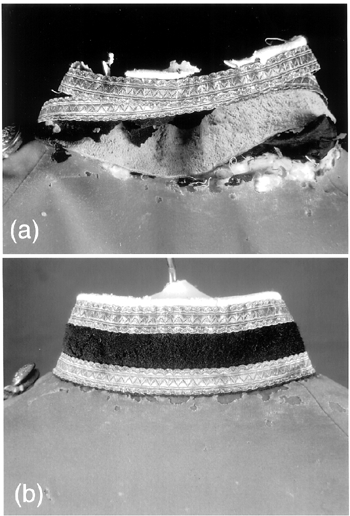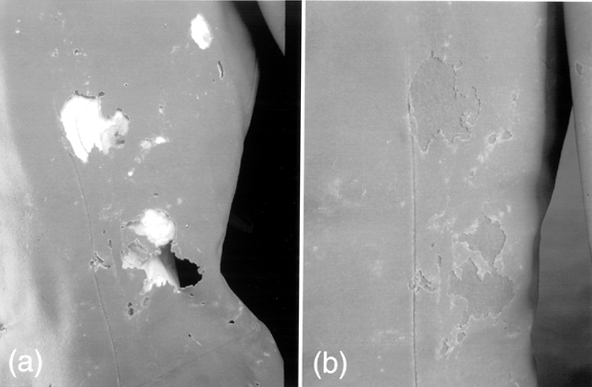CONSERVATION OF A MILITARY TUNIC INCLUDING THE USE OF GUIDE THREADS FOR POSITIONING REPAIRSJAN VUORI, & ROBIN HANSON
3 3. CONDITIONTwo aspects of the tunic's condition rendered it unexhibitable. The collar was largely destroyed, and large holes in the PR front not only were unsightly but also were structurally unstable. In its fractured state, the tunic did not provide a complete example of what a 19th-century military tunic looked like. Moreover, even though the lining is not visible, it is an important element of the tunic's construction. The severely deteriorated condition of the silk put it at risk of further loss if the tunic was handled for study or placed on a support or mannequin for display. All the wool elements of the tunic had been extensively attacked by insects. The damage included loss of nap, sometimes referred to as “grazing,” and numerous holes ranging in size from that of a pinhead to 4 cm in diameter. The largest losses were on the collar, as seen in figure 4a, and on the PL front torso, as seen in figure 7a. Indeed, the collar was the most severely damaged element of the tunic; approximately 60% of the navy blue wool and cream-colored piping was missing, revealing the leather stiffening layer beneath. The red wool surrounding the collar had numerous areas of loss as well. With so little wool fabric remaining in the collar to support it, the bottom row of silver lace was left hanging loose, attached only at the ends with original stitches as well as with what appeared to be repair stitches. Losses of red wool, white piping, or buttonhole stitching around the fifth, sixth, and eighth buttonholes (counting down from the neck edge) rendered these areas susceptible to further damage when the buttons were fastened or unfastened (necessary for placing the tunic on a support for display).
This insect damage probably had occurred long ago, as there were no signs of active infestation and the museum reported no problems with insects. However, because larvae could have been hidden within the layers of the tunic, as a precautionary measure upon its arrival at CCI, the tunic was sealed in a polyethylene bag and placed in a freezer at −40�C for 48 hours (CCI 1997). The silk twill used to line the top portion of the tunic was structurally and aesthetically in very poor condition. Not only was the silk degraded, with numerous splits and fragments, but large areas were missing, thereby exposing the cotton batting. Over much of this area, the only thing keeping the lining fragments from being separated from the tunic was the stitches used to quilt the lining to the underlying cotton batting. It does not appear that the stitching itself was the cause of damage. Rather, it seems that wear and tear caused this damage to the rather lightweight silk fabric. (The silk was not analyzed for the presence of weighting or bleaching agents, but if present these would have contributed to the deterioration of the silk.) The lining in the underarm area was particularly discolored, brittle, and fragmenting due to the effects of perspiration on the fibers. Small fragments of silk were dislodged whenever material used to pad out the sleeve, such as acid-free tissue, was inserted or removed. The lining in the rest of the sleeves was in quite good condition. The leather waistband also was very fragile. Approximately 50% was missing, and the remaining leather was in poor condition. In some areas, the top surface had delaminated and become lost, revealing a suedelike surface beneath, which was powdery and rusty red. In other areas the leather was dark, stiff, brittle, and cracked. The shrinkage temperature of the leather, determined by microscopic methods, ranged from 33�C to 42�C, very low compared to the range for vegetable-tanned leathers in good condition, that is, 75�C to 85�C. All of this indicated that the leather was very degraded and that no water-based consolidants or adhesives could be used in its repair (Young 1990). Both the silver lace and the buttons were tarnished except for areas that had been protected, such as the underside of the buttons. The silver plating on the buttons had been polished away from the high points of the relief design, thereby revealing the underlying copper. Residues of metal polish were present in the crevices of the relief design of the buttons, as well as on the textile fibers adjacent to the buttons, including on the braided cord on the PL shoulder. Although the tunic was not noticeably dirty, it bore some common signs of use, such as soiling and discoloration, around the pocket in the waist seam and on the underarms of the sleeves. |

